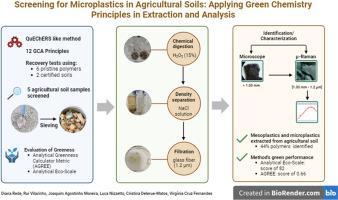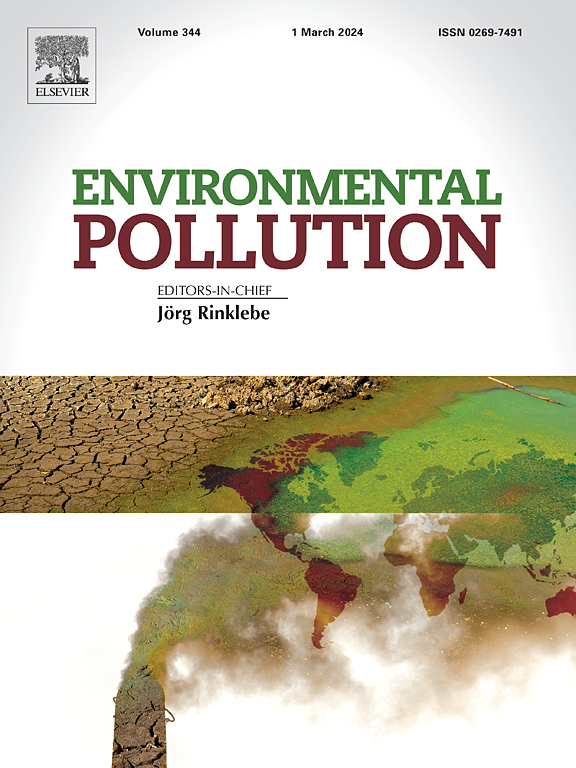Screening for microplastics in agricultural soils: Applying green chemistry principles in extraction and analysis
IF 7.3
2区 环境科学与生态学
Q1 ENVIRONMENTAL SCIENCES
引用次数: 0
Abstract
In recent years, microplastic (MP) pollution has garnered significant attention owing to its ability to permeate various ecosystems, including soil. These particles can infiltrate the environment, either directly or through the degradation of larger plastic items. Despite growing concerns, standardized methods for quantification are still lacking. This study aimed to screen for the presence of MPs in agricultural soils while incorporating green analytical principles in the methodology. A density separation followed by centrifugation was employed, based on the principles of the QuEChERS extraction method. This approach minimized sample quantities, reagent consumption, and waste production, ensuring efficient extraction and analysis. Recovery tests using certified soils spiked with pristine MPs, specifically polystyrene, polypropylene (PP), and ethylene-vinyl acetate for larger MPs (3–5 mm), and low-density polyethylene, polyamide 6, and tire wear particles for smaller MPs (15–300 μm), achieved recovery levels exceeding 69% for smaller MPs and over 91% for larger particles. Spectroscopic analysis revealed slight alterations in the Raman spectra of MPs after extraction. Transitioning to agricultural soil analysis has revealed challenges, including spectral interferences. Nine mesoplastics (5–20 mm) were detected, predominantly consisting of PP and polyethylene (PE), along with seven MPs, three of which were individually identified as PE-based, while the remainder were inconclusive, including one fiber. The evaluation of the method's sustainability using the Analytical Eco-Scale and Analytical Greenness Calculator Metric (AGREE), with scores of 82 out of 100 and 0.66 out of 1, respectively, demonstrated its potential as a reliable approach to MP analysis in soils. This study highlights the potential of integrating green analytical chemistry principles into MP extraction methodologies and emphasizes the value of the proposed QuEChERs-based approach for improving the sustainability and efficiency of MP monitoring in agricultural soils.


农业土壤中微塑料的筛选:绿色化学原理在提取分析中的应用
近年来,微塑料污染因其能够渗透到包括土壤在内的各种生态系统而引起了广泛关注。这些颗粒可以直接或通过较大塑料物品的降解渗透到环境中。尽管越来越多的关注,标准化的量化方法仍然缺乏。本研究旨在筛选农业土壤中MPs的存在,同时将绿色分析原则纳入方法中。根据QuEChERS萃取法的原理,采用密度分离后离心的方法。这种方法最大限度地减少了样品数量,试剂消耗和废物产生,确保了有效的提取和分析。使用经过认证的土壤进行恢复测试,其中添加了原始MPs,特别是聚苯乙烯,聚丙烯(PP)和乙烯-醋酸乙烯酯,用于较大的MPs(3-5毫米),以及低密度聚乙烯,聚酰胺6和轮胎磨损颗粒,用于较小的MPs (15-300 μm),恢复水平超过69%,较大颗粒的恢复水平超过91%。光谱学分析显示萃取后MPs的拉曼光谱有轻微变化。向农业土壤分析的过渡揭示了包括光谱干扰在内的挑战。检测到9种中塑料(5-20毫米的塑料制品),主要由PP和PE组成,以及7种MPs,其中3种被单独确定为PE基,而其余的则不确定,包括一种纤维。使用分析生态尺度和分析绿色计算器度量(AGREE)对该方法的可持续性进行评估,得分为82分(满分为100分)和0.66分(满分为1分),证明了它作为土壤中MP分析的可靠方法的潜力。本研究强调了将绿色分析化学原理整合到MP提取方法中的潜力,并强调了提出的基于quechers的方法在提高农业土壤中MP监测的可持续性和效率方面的价值。
本文章由计算机程序翻译,如有差异,请以英文原文为准。
求助全文
约1分钟内获得全文
求助全文
来源期刊

Environmental Pollution
环境科学-环境科学
CiteScore
16.00
自引率
6.70%
发文量
2082
审稿时长
2.9 months
期刊介绍:
Environmental Pollution is an international peer-reviewed journal that publishes high-quality research papers and review articles covering all aspects of environmental pollution and its impacts on ecosystems and human health.
Subject areas include, but are not limited to:
• Sources and occurrences of pollutants that are clearly defined and measured in environmental compartments, food and food-related items, and human bodies;
• Interlinks between contaminant exposure and biological, ecological, and human health effects, including those of climate change;
• Contaminants of emerging concerns (including but not limited to antibiotic resistant microorganisms or genes, microplastics/nanoplastics, electronic wastes, light, and noise) and/or their biological, ecological, or human health effects;
• Laboratory and field studies on the remediation/mitigation of environmental pollution via new techniques and with clear links to biological, ecological, or human health effects;
• Modeling of pollution processes, patterns, or trends that is of clear environmental and/or human health interest;
• New techniques that measure and examine environmental occurrences, transport, behavior, and effects of pollutants within the environment or the laboratory, provided that they can be clearly used to address problems within regional or global environmental compartments.
 求助内容:
求助内容: 应助结果提醒方式:
应助结果提醒方式:


